SERIES ANALYSIS: Early Silver Dollars -- the ‘Proofs’ of 1801 to 1804 (Part 4)
Part 4, the final installment, of Greg Reynolds series analysis on the draped bust silver dollars focuses on the proof issues that were issued from 1801-1804. These controversial issues, also called novadels, are a fascinating piece of numismatic lore and include the very famous 1804 dollar.
Although the 1804 silver dollar is the most famous United States coin, it was backdated. No 1804 dollars were struck before the 1830s, and 1804 dollars were restruck in 1858 and later. These tend to be categorized with backdated 1801, 1802 and 1803 Draped Bust, Heraldic Eagle silver dollars that were specially struck at times that are currently unknown, though probably not before 1858. All are novodels. No one now knows for certain why the silver dollar and the eagle ($10 gold coin) in ‘year 1834’ coin sets were backdated “1804,” though 1804 was the last year before the 1830s that coins of these two denominations were made for circulation.
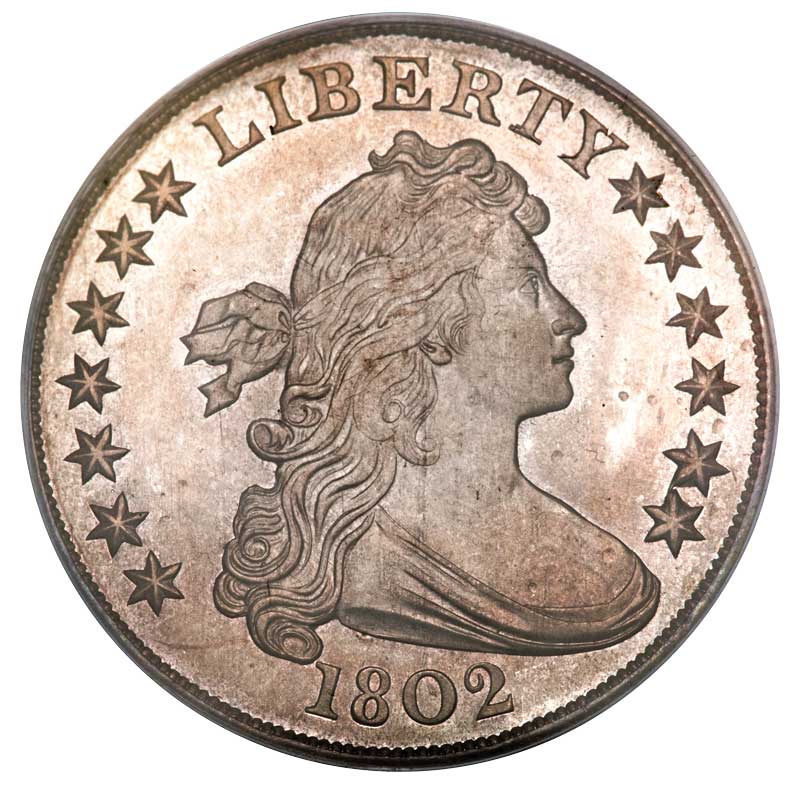
Proof 1802 Bust dollar obverse (Photo courtesy of Heritage Auctions)
Although some may not clearly fulfill the criteria for Proof status, and the physical characteristics vary among the Draped Bust dollars that were struck decades after 1804, the 1801, 1802 and 1803 novodels, along with 1804 dollars, are all classified as “Proofs” by tradition. Clearly, the respective textures of the surfaces of these are much different from the fabric of business strike Draped Bust, Heraldic Eagle dollars that were struck from 1798 to 1804. Also, the border elements and rims of the backdated Draped Bust dollars (novodels) are much different from those of Draped Bust dollars that were struck before 1805.
While the definition of ‘novodel’ employed in Europe is more encompassing, the term novodel here refers to backdated coins that were made from dies that imitate, are almost alike and/or were modeled after, the dies that were employed to strike coins during the era that corresponds to the year on each backdated coin. In 1834 and/or 1835, 1804 eagle novodels were made as well. Silver dollars truly made in 1804 were dated 1803 or possibly 1802. Some or all business strike eagles ($10 gold coins) made in 1804 were dated 1804. The backdated Proof “1804” eagles are unlike the original business strikes. One notable difference is that the numeral ‘4’ is of a different font.
The 1804 silver dollar is the most sought after of all the novodels and has an interesting story. On Nov. 11, 1834, Secretary of State John Forsyth wrote a letter to Samuel Moore, then director of the U.S. Mint. The first sentence is the most important, “The President has directed that a complete set of the coins of the United States be sent to the King of Siam [Thailand], and another to the Sultan of Muscat [Oman]” (https://tinyurl.com/1804Letter). Other 1834 U.S. coin sets were supposed to be delivered to the Emperors of Cochin-China [Vietnam] and Japan, respectively, but the fate of these sets is unclear. The pertinent U.S. envoy died unexpectedly on June 12, 1836 in Macau.
The only original case that survives is that which accompanies the set that was presented to the King of Siam (Thailand) in April 1836 by this U.S. envoy. Most of the original set survives, including the ‘King of Siam’ 1804 dollar and 1804 eagle. When the ‘King of Siam’ set was publicized by David Spink in 1962, two coins were missing, one of which was an 1834 half dime. Later, the missing coins were replaced with appropriate 1834 coins.
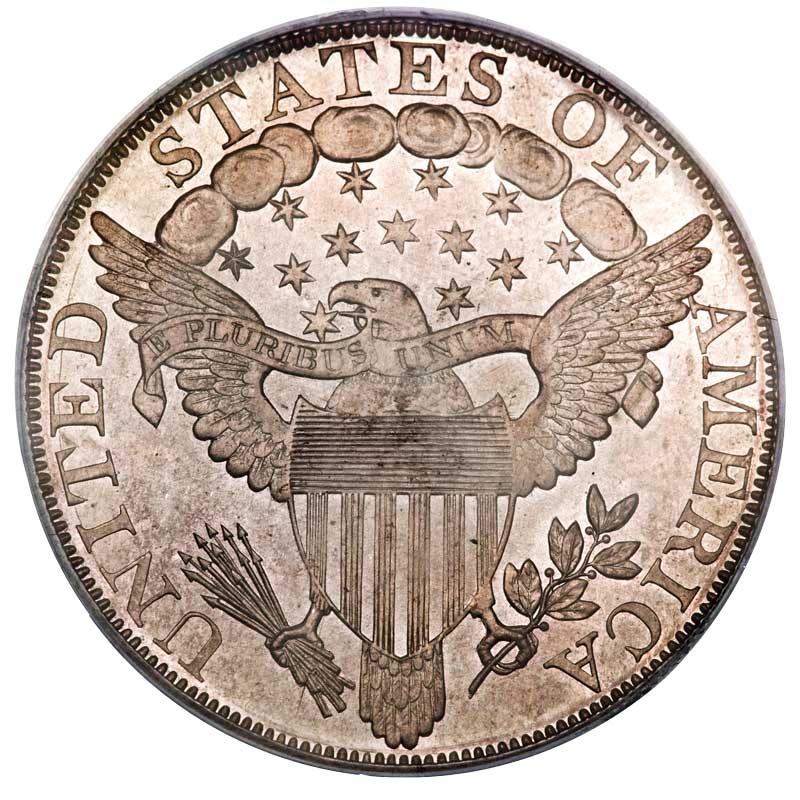
Proof 1802 Bust dollar reverse (Photo courtesy of Heritage Auctions)
Those 1804 dollars that were struck in 1834 and/or 1835 are called “originals,” though “Class I” is a more logical term. The standard reference for 1804 dollars is a book by Eric Newman and Kenneth Bressett, “The Fantastic 1804 Dollar” (Whitman books, 1962, 2009). Additionally, in a volume of papers relating to the COAC conference of 1993, published by the ANS in 1995, Eric Newman contributed an appendix, which restated his research findings and conclusions regarding 1804 dollars.
The second leading reference regarding 1804 dollars is Q. David Bowers’ encyclopedia of silver dollars and Trade dollars, which was first published in 1993 and has since been republished on the PCGS web site. Another noteworthy reference is the series of essays published in Heritage Auction’s pre-ANA auction catalogue of August 2013 (https://tinyurl.com/1804in2013). Additionally, R. W. Julian has discussed 1804 dollars in innumerable published articles and in private correspondence with me.
R. W. Julian has demonstrated that resumption of silver dollar production was authorized by President Jackson in 1831. Julian theorized that the dies used for 1804 dollars and for the 1801-02-03 novodels were made in 1831 or 1832 (https://tinyurl.com/RWJ1831). Perhaps Philadelphia Mint officials then wished to be prepared if they were ordered to immediately produce silver dollars again.
“On August 13, 1832, the Mint paid Merrick & Agnew $650 for silver dollar moulds. There is no doubt that the moulds would have been tested by a trial coinage run,” R. W. Julian reveals in recent e-mails to me. Julian explains that a “mould is used to prepare an ingot, which is then rolled down to the proper thickness” to prepare blanks (planchets) for coinage.
Eric Newman theorized that the exact same group of dies that Julian says were made circa 1831 were really made late in 1834, in case 1804-dated dies were found to be unacceptable in 1834 (ANS, 1995, https://tinyurl.com/COAC1993). Evidently, Newman figured that the U.S. Mint implemented some kind of backup plan to be certain that the president’s order for presentation sets was followed on time in a manner that was acceptable to relevant officials. For different reasons, Newman and Julian were in agreement that the dies for all the silver dollar novodels were prepared before 1835, with the qualifier that the 1801 obverse die was then incomplete.
I do not find either theory to be completely convincing. While it is very plausible that two reverse dies were finished during 1834 or already existed, it seems unlikely that 1802 and 1803 obverse dies would have been made during the 1830s. Also, both these theories are based upon notions that Philadelphia Mint officials were diligent about being prepared to strike silver dollars to satisfy expectations of officials higher in the government.
In 1831 or 1832, the Philadelphia Mint probably made silver dollar dies for patterns or dies just for the testing of equipment. Relatively new equipment and technologies had been adopted since 1804. If Philadelphia Mint officials were preparing to strike silver dollars for circulation in 1832, would the dies really be backdated by more than a quarter-century? Would the Draped Bust design have been considered for circulating coins during the 1830s? This design had been abandoned before 1808! Is it more likely that they were thinking about making Capped Bust silver dollars?
The preparations and backup plan imagined by Newman are hard to believe. Were “1804” dollars carefully made and the result of extensive preparations?
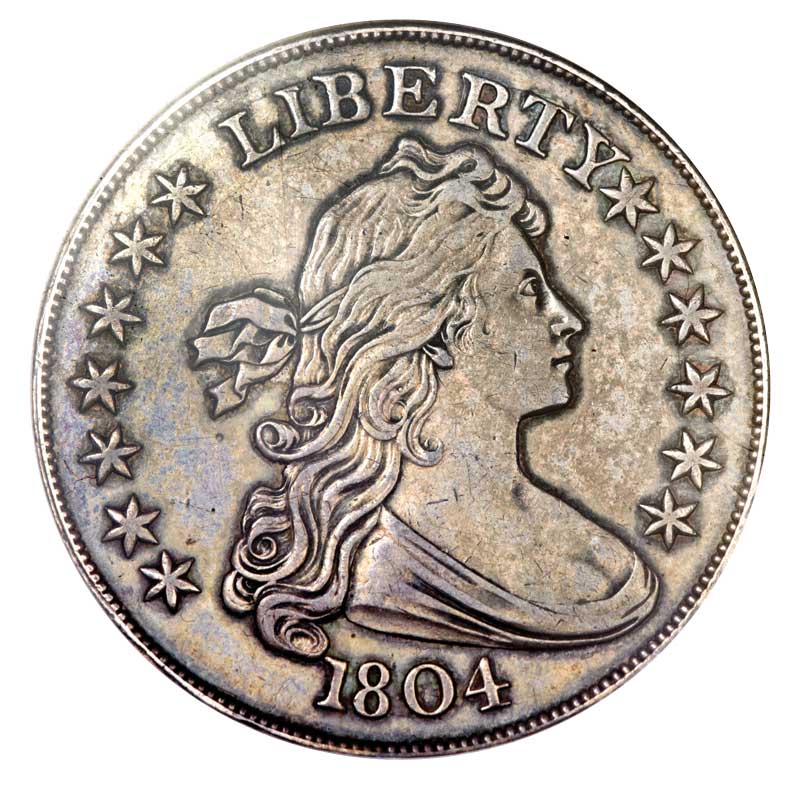
The famous 1804 Bust dollar obverse (Photo courtesy of Heritage Auctions)
In my view, “1804” dollars and 1834 silver coins in general that are currently certified as Proofs are not all that well struck or particularly well made in the context of U.S. Proof coinage and special strikings overall. Indeed, several 1834-dated silver coins that are certified as “Proofs” barely qualify as Proofs, are non-Proof Special Strikings, or are prooflike business strikes. There are U.S. coins from the 1820s that have far more powerful Proof characteristics than many 1834 silver coins that are currently certified as Proofs, including at least a couple pieces in the King of Siam set, and have stronger Proof characteristics than some Class I 1804 dollars.
It is likely that Philadelphia Mint employees were in a hurry to have sets ready for the U.S. envoy to take on his voyage by sea to Asia. There could have been an additional dateless pair of silver dollar dies as a backup in case the “original” pair of “1804” dies fractured while in use. Original punches could have been stored with the silver dollar dies that were prepared during the 1830s. Pertinent activity resumed in 1858. Indeed, from 1858 to 1860, a significant number of novodels, restrikes and unusual patterns of many denominations were made for collectors. It is known that Class II 1804 dollars were sold to collectors during 1858 and these were later recovered by the Philadelphia Mint after some collectors complained about the prices and the unfairness of this unofficial program. The lone surviving Class II 1804 dollar was struck over an 1857 Swiss coin. This piece is in the Smithsonian. The Class II and Class III 1804 dollars were struck with the same obverse as the Class I coins, but with a different reverse die. The general belief is that Class II 1804 dollars each had a plain edge, while Class III 1804 dollars each have a lettered edge that was imparted well after striking. It is also believed that most the Class III 1804 dollars were formerly Class II 1804 dollars that were subjected to edge lettering years after they were minted (see Bressett, https://tinyurl.com/COAC1986, & Heritage, https://tinyurl.com/1804in2013, ha.com/1276*4003).
In addition to the controversy as to when the 1801-02-03 dollar dies were made, there is even more of a controversy regarding when these dies were used to strike novodels. I cover this controversy in my article on “Proof 1802 Silver Dollars” that was published on October 10, 2012 (https://tinyurl.com/Proof1802dollars).
R. W. Julian has presented arguments as to why substantially overweight planchets were available and were likely to have been used for novodels during the 1850s. Planchets of proper weight were subject to accounting and security precautions, while overweight planchets could just be taken for patterns and particular Proofs if the equivalent in silver bullion was substituted. Bureaucratic regulations and detailed paperwork were avoided.
Since the 1960s, R. W. Julian has been extensively researching and analyzing original government documents relating to U.S. coinage. Bob concludes that zero 1801, 1802, 1803 or 1804 dollars were struck during the 1870s. If Julian is correct, then there must be an explanation for the use of planchets that weigh around 420 grains each for the production of Proof 1802 and 1803 silver dollar novodels.
After January 1837, silver dollars were specified to weigh 412.5 grains. Trade dollars were specified to weigh 420 grains, though Trade dollars were not minted until 1873.
Could all the planchets for the 1801-02-03 novodels been taken from one consistently bad batch of overweight planchets? I find that 1801-02-03 novodels physically differ with regard to each other and were probably not all struck during the same day or even during the same week.
Regardless of when they were struck, all these novodels are prohibitively rare. There are fifteen surviving 1804 dollars, eight of which are Class I coins. Five of those eight are owned by collectors, and three Class III 1804 dollars are owned by collectors. The Smithsonian has one of each class, thus three in total. The ANA museum has two 1804 dollars and the ANS has one. A museum in Omaha has a Class I 1804 dollar.
Curiously, there are only two known “Proof” 1801 dollars. The Carter-French 1801 was auctioned by Stack’s (NY) on January 18, 1989. In October 2013, NGC announced that another 1801 dollar had then been certified as “Proof-66 Cameo.” As for 1802 novodels, my already mentioned article provides circumstantial evidence that five are known. Four “Proof” 1803 dollars are often listed in auction catalogues and other references. The sheer volume of auction appearances and dealer-sales of “Proof” 1803 dollars suggests, however, that there could very well be five around.
While the fame of 1804 dollars is tremendous, how important are 1801-02-03 novodels? Are such novodels inconsequential fantasies or are they extremely important parts of the history of coin collecting in the U.S.? Either way, they are fascinating and attractive relics of the history of the Philadelphia Mint!
# # #
Copyright 2020 Greg Reynolds
Insightful10@gmail.com

Download the Greysheet app for access to pricing, news, events and your subscriptions.
Subscribe Now.

Subscribe to The Greysheet for the industry's most respected pricing and to read more articles just like this.
Source: Greg Reynolds
Related Stories (powered by Greysheet News)
View all news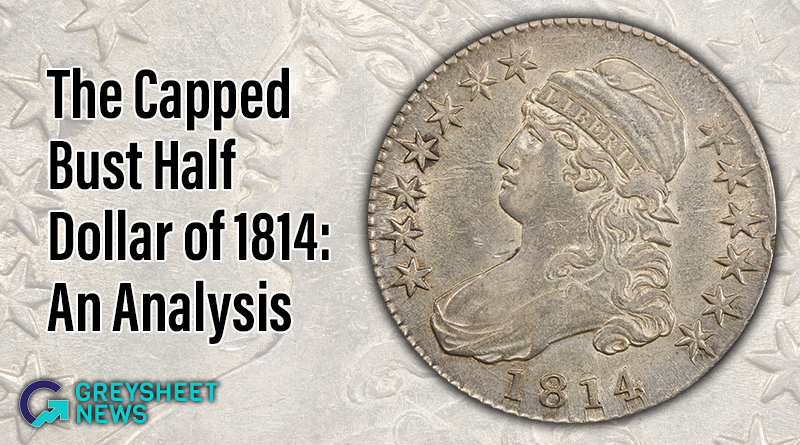
In this article Greg Reynolds analyzes the 1814 Capped Bust Half Dollar.
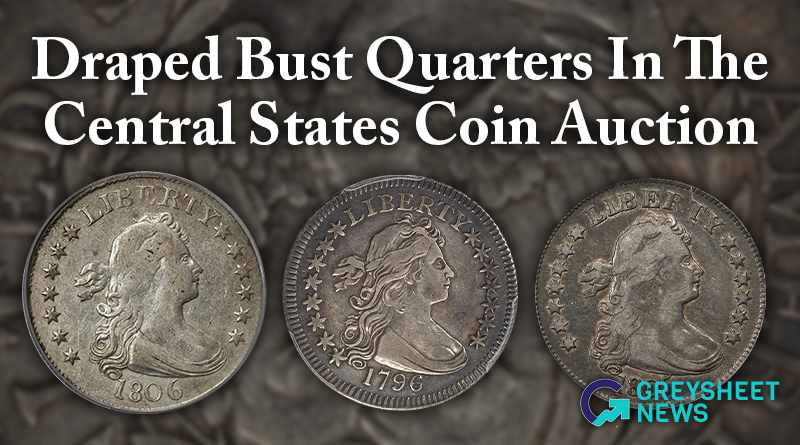
The Lusk set of Draped Bust quarters brought strong results.
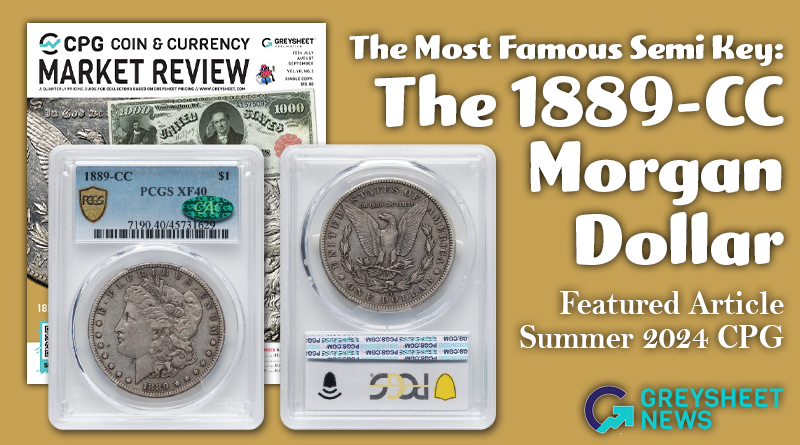
The 1889-CC is the second scarcest business strike in the series.


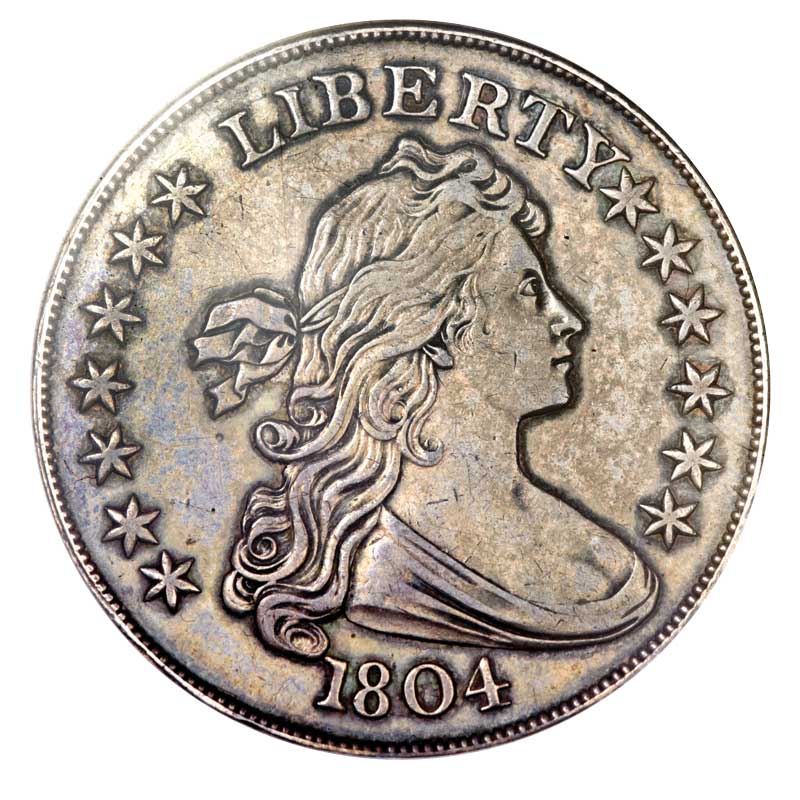






Please sign in or register to leave a comment.
Your identity will be restricted to first name/last initial, or a user ID you create.
Comment
Comments